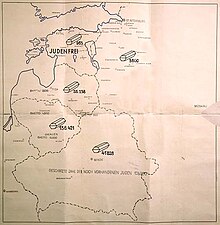Judenfrei

Synagogue in German-occupied Bydgoszcz. The inscription reads: "This city is free of Jews"

German map showing the number of Jewish executions carried out by Einsatzgruppe A in: Estonia (declared "Judenfrei"), Latvia, Lithuania, Belarus and Russia
The Nazi terms judenfrei (German: [ˈjuːdn̩ˌfʁaɪ], "free of Jews") and judenrein (German: [ˈjuːdn̩ˌʁaɪn], "clean of Jews") designated an area that was "cleansed" of Jews during The Holocaust.[1]
While judenfrei referred merely to "freeing" an area of all of its Jewish inhabitants, the term judenrein (literally "clean of Jews") was also used. This had the stronger connotation that any trace of Jewish blood had been removed as an impurity.[2]
Locations declared judenfrei
Establishments, villages, cities, and regions were declared judenfrei or judenrein after they were cleansed of Jews.
Gelnhausen, Germany – reported judenfrei on November 1, 1938, by propaganda newspaper Kinzigwacht after its synagogue was closed and remaining local Jews forced to leave the town.[3]
- German-occupied Bydgoszcz (Poland) – reported judenfrei in December 1939.
- German-annexed Alsace - reported judenrein by Robert Heinrich Wagner in July 1940.[4]
Banat, German-occupied territory of Serbia - reported judenfrei on 19 August 1941 in Völkische Beobachter (lit. People's Observer).[5] On 20 August 1941 Banat was declared judenfrei by its German administrators.[6]
- German-occupied Luxembourg – reported judenfrei by the press on October 17, 1941.[7]
- German-occupied Estonia – December 1941.[8] Reported as judenfrei at the Wannsee Conference on January 20, 1942.[9]
German-occupied territory of Serbia / Belgrade – May 1942, reported in the SS-Standartenführer Emanuel Schäfer cable sent to the Reich Main Security Office in Berlin; Schäfer was the Der Befehlshaber der SIPO und des SD head that time in Belgrade.[10][11][12][13]
Vienna – reported judenfrei by Alois Brunner on October 9, 1942.
Berlin, Germany – May 19, 1943.[14]
Erlangen, Germany was declared judenfrei in 1944.
Independent State of Croatia – April 18, 1944. reported judenfrei by Siegfried Kasche to Berlin on 18 April 1944 that "Croatia is one of the countries in which the Jewish problem has been solved".[15][16]
Usage in Israeli–Palestinian conflict
In the Israeli-Palestinian conflict, a fear among many Israelis which has been reflected by Israeli government officials such as Benjamin Netanyahu[17] is that the proposed removal of Israeli Jewish settlements in the West Bank according to the wishes of Palestinian officials is tantamount to rendering these areas Judenrein, or clean of Jews.
On July 9, 2009, Benjamin Netanyahu, in a discussion with the German foreign minister Frank-Walter Steinmeier is reported to have said, using the Israeli terms of the area, "Judea and Samaria cannot be judenrein."[18]
In 1952 Pesach Lev, first mayor of Lod after it was resettled by Israelis, said that Lod was transformed from "a neglected Arab town that was judenrein to a 'Hebraic city'".[citation needed]
References
^ Scheffler, Wolfgang (2007). "Judenrein". Encyclopaedia Judaica (2 ed.). Thomson Gale..mw-parser-output cite.citation{font-style:inherit}.mw-parser-output .citation q{quotes:"""""""'""'"}.mw-parser-output .citation .cs1-lock-free a{background:url("//upload.wikimedia.org/wikipedia/commons/thumb/6/65/Lock-green.svg/9px-Lock-green.svg.png")no-repeat;background-position:right .1em center}.mw-parser-output .citation .cs1-lock-limited a,.mw-parser-output .citation .cs1-lock-registration a{background:url("//upload.wikimedia.org/wikipedia/commons/thumb/d/d6/Lock-gray-alt-2.svg/9px-Lock-gray-alt-2.svg.png")no-repeat;background-position:right .1em center}.mw-parser-output .citation .cs1-lock-subscription a{background:url("//upload.wikimedia.org/wikipedia/commons/thumb/a/aa/Lock-red-alt-2.svg/9px-Lock-red-alt-2.svg.png")no-repeat;background-position:right .1em center}.mw-parser-output .cs1-subscription,.mw-parser-output .cs1-registration{color:#555}.mw-parser-output .cs1-subscription span,.mw-parser-output .cs1-registration span{border-bottom:1px dotted;cursor:help}.mw-parser-output .cs1-ws-icon a{background:url("//upload.wikimedia.org/wikipedia/commons/thumb/4/4c/Wikisource-logo.svg/12px-Wikisource-logo.svg.png")no-repeat;background-position:right .1em center}.mw-parser-output code.cs1-code{color:inherit;background:inherit;border:inherit;padding:inherit}.mw-parser-output .cs1-hidden-error{display:none;font-size:100%}.mw-parser-output .cs1-visible-error{font-size:100%}.mw-parser-output .cs1-maint{display:none;color:#33aa33;margin-left:0.3em}.mw-parser-output .cs1-subscription,.mw-parser-output .cs1-registration,.mw-parser-output .cs1-format{font-size:95%}.mw-parser-output .cs1-kern-left,.mw-parser-output .cs1-kern-wl-left{padding-left:0.2em}.mw-parser-output .cs1-kern-right,.mw-parser-output .cs1-kern-wl-right{padding-right:0.2em}
^ "Aryanization: Judenrein & Judenfrei". shoaheducation.com.
^ "'Gelnhausen endlich judenfrei': Zur Geschichte der Juden während der Nationalsozialistischen Verfolgung" ['Gelnhausen finally free of Jews': On the History of the Jews during the Nazi persecution] (PDF) (in German). Archived from the original (PDF) on September 28, 2007.
^ Blumenkranz, Bernhard; Catane, Moshe (2007). "Alsace". Encyclopaedia Judaica (2 ed.). Thomson Gale.
^ Drndić, Daša (2009). April u Berlinu. Fraktura. p. 24. ISBN 978-953-266-095-1.Njemački list Völkische Beobachter objavio je 19. kolovoza 1941. da je Banat konačno Juden frei.
^ Muth, Thorsten (2009). Das Judentum: Geschichte und Kultur. Pressel. p. 452. ISBN 978-3-937950-28-0.Am 20. August konnte die deutsche Führung das Banat für Judenfrei" erklären.
^ "Commémoration de la Shoah au Luxembourg" [Commemoration of the Shoah in Luxembourg] (in French). Government of Luxembourg. July 3, 2005. Archived from the original on September 30, 2007.
^ "Extract from Report by Einsatzgruppe A". Archived from the original on November 12, 2007. Partial Translation of Document 2273-PS Source: Nazi Conspiracy and Aggression, Vol. IV. USGPO, Washington, 1946, pp. 944–949
^ "Estonian Jews". Simon Wiesenthal Center. Archived from the original on September 28, 2007. sourced to Encyclopedia of the Holocaust. New York: Macmillan Publishing Company. 1990.
^ Lituchy, Barry M. Jasenovac and the Holocaust in Yugoslavia: analyses and survivor testimonies. Jasenovac Research Institute. pp. xxxiii. ISBN 978-0-97534-320-3.
^ Manoschek, Walter (1995). "Serbien ist judenfrei": militärische Besatzungspolitik und Judenvernichtung in Serbien 1941/42. Walter de Gruyter. p. 184. ISBN 9783486561371.
^ Lebel, G'eni (2007). Until "the Final Solution": The Jews in Belgrade 1521 - 1942. Avotaynu. p. 329. ISBN 9781886223332.
^ Herbert, Ulrich; Schildt, Axel (1998). Kriegsende in Europa. Klartext. p. 149. ISBN 9783884745113.
^ "Was war am 19. Mai 1943" [What was on May 19, 1943] (in German). chroniknet.
^ Jewish History of Yugoslavia, porges.net; accessed 5 May 2016.
^ "Povijest Židova Jugoslavije" (in (in French)). Porges.net. Retrieved 12. 08. 2015. Check date values in:|accessdate=(help)CS1 maint: Unrecognized language (link)
^ Dan Williams (July 9, 2009). "Judenrein! Israel adopts Nazi term to back settlers". Reuters.
^ "German FM: Settlements Remain Obstacle to Peace; Frank-Walter Steinmeier says is encouraged by Israel's acceptance of a two-state solution". Haaretz. Reuters and DPA. July 9, 2009.